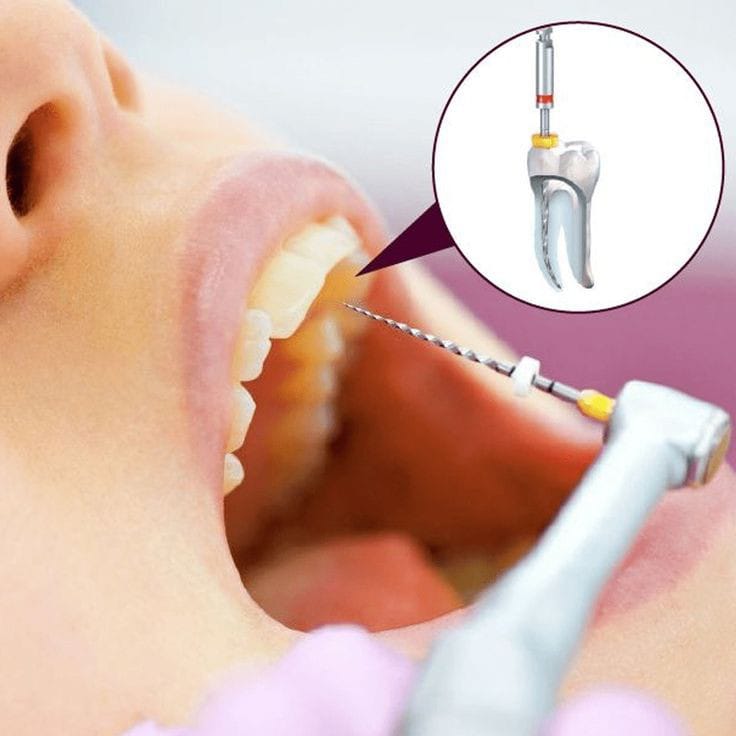
ROOT CANAL TREATMENT
A Root Canal Treatment Is A Dental Procedure To Remove Inflamed Or Infected Pulp On The
Inside Of The Tooth Which Is Then Carefully Cleaned And Disinfected, Then Filled And
Sealed. Root Canal Treatment Is Designed To Eliminate Bacteria From The Infected Root Canal,
Prevent Reinfection Of The Tooth And Save The Natural Tooth.
Traditionally RCT Has Been Divided Into Two Or More Appointments To Disinfect The Canal,
Improve Patient Comfort And Observe Healing Before Permanent Filling. However One-Visit
Endodontic Treatment Is Faster, Well Accepted By Patients And Prevents The Recontamination
Of Root Canals Between Appointments.
Single Visit Rct-
Single-Visit RCT
This Method Is Faster, More Convenient For Patients, And May Be Less Expensive. It
Alsoprevents The Root Canal From Becoming Recontaminated Between Appointments.
Multiple-Visit RCT
This Method Involves Placing A Short-Term Medicament, Like Calcium Hydroxide, Between
Appointments. It May Be Better For Certain Complex Cases Because It Allows For Interim
Microbial Control.
When Do We Need Rct –
- A Chipped Or Cracked Tooth:
Many Chipped And Cracked Teeth Are The Result Of An Accident Or Biting On
Something Hard. Even The Tiniest Chip Or Hairline Crack In Your Tooth Is Enough To
Allow Harmful Bacteria Into The Inner Area Of Your Tooth To Gradually Cause Decay
And Set Up An Infection.
If You Seek Treatment For A Chipped Or Cracked Tooth Immediately, You Likely Can
Avoid A Full-Blown Infection And The Need For Root Canal Therapy. Persistent Toothache:
The Truth Is, That Not All Types Of Tooth Pain Are Indications For A Root Canal, So It
Can Be Difficult During Those Early Stages Of A Problem To Know If Better Oral
Hygiene Efforts Can Solve The Issue Or If Dental Work Is Required. Obviously, A
Horrible Toothache Is A Major Sign That You May Need A Root Canal. It May Be A
Continuous Throb Or It May Come And Go, But Strong And Persistent Tooth Pain,Especially If It Gets Worse When Eating, Biting Down, Or Otherwise Disturbing The
Tooth, Is A Signal That You Need To Make An Appointment To Visit The Dentist As
Soon As Possible.
It’s Important To Remember That Tooth Pain Seldom Goes Away On Its Own And You
Need To See A Dentist To Address The Underlying Problem That’s Causing The Pain.- Lingering Sensitivity:
Painful Sensitivity To Hot Or Cold That Does Not Dissipate Quickly Is A Possible Sign
Of Damage To The Nerve Within Your Tooth, And This Can Be An Indicator That You
May Need A Root Canal. - A Darkened Or Discolored Tooth:
Has One Of Your Teeth Suddenly Turned Grey Or Black? While Some Tooth
Discoloration Is Common, And Can Be Amended With A Teeth Whitening Treatment,
Having A Severely Discolored Tooth Is Indicative Of Severe Tooth Decay Or The
Breakdown Of Internal Tissue And Might Be A Sign That Root Canal Treatment Is Needed. - Swelling:
Swelling Does Not Always Indicate That There Is A Need For Root Canal Surgery.
However, Any Swelling Of The Face And Jaw, Ranging From Barely Noticeable To
Severe, Is One Of The Most Common Signs That A Tooth Is Infected. Especially If It’s
Accompanied By Swelling In The Gums Surrounding A Tooth, And Tooth Pain. This
Could Be A Sign That Tooth Decay Has Spread To The Gums Through The Root Of The Tooth, And Chances Are You Have Developed A Dental Abscess That Can Only Be Cleared By A Root Canal Treatment And Antibiotics To Curb The Infection. - Bump On The Gum:
A Pimple-Like Bump On Your Gum Is A Dental Abscess And Is An Indication Of A
Severe Infection In The Area Of Your Tooth Where The Sensitive Inner Layer That
Contains Arteries And Nerve Endings. This Results In Deep Pockets Full Of Pus
Forming Around The Tooth Root. In Addition To Being Incredibly Painful, You May
Also Experience Symptoms Like Facial Swelling, Swollen Lymph Nodes, And A Fever.
An Abscess Requires Immediate Treatment With Antibiotics And A Root Canal.
Does A Root Canal Hurt?
A Root Canal Procedure Sounds Scary, But With Today’s Technology, It’s Typically Not A
Whole Lot More Different Than Having A Deep Filling. There’s Little To No Pain Because
Dentist Will Use Local Anesthesia To Numb Your Tooth And Gums So You’re Comfortable
During The Procedure.
If You Need A Root Canal And Have Facial Swelling Or A Fever, Dentist May Give You
Antibiotics Beforehand To Kill The Infection. This May Also Help Reduce Your Pain.
The Root Canal Procedure Itself Is Similar To Getting A Large Filling, But It’ll Take Longer.
Your Mouth Will Be Numbed While The Dentist Cleans Out The Decay, Disinfects The Roots,
And Then Fills Them In.
Dentist Will Use A Rubber Dam Around The Root Canal Tooth. This Will Help Prevent Any
Infected Material From Spreading To The Rest Of Your Mouth.
Your Mouth May Feel Sore Or Tender After The Root Canal. Dentist May Suggest That You
Take An Over-The-Counter Pain Medication Such As Acetaminophen (Tylenol) Or Ibuprofen
(Advil).
How To Prevent A Root Canal
To Prevent A Root Canal, It’s Important To Follow The Same Dental Hygiene Habits That Help
Prevent Cavities And Other Tooth Problems. To Keep Your Teeth Healthy, Try To Get Into The
Habit Of Following These Steps:
Brush Your Teeth At Least Twice A Day.
Floss Between Your Teeth At Least Once A Day.
Use Fluoride Toothpaste Or A Fluoride Rinse.
- See Your Dentist For Checkups Every 6 Months.
Have Your Teeth Professionally Cleaned By Your Dentist At Least Once A Year.
Try To Limit The Amount Of Sugary Food And Refined Carbohydrates You Eat. These
Foods Have A Tendency To Stick To Your Teeth. If You Eat Sugary Foods, Try To
Rinse Your Mouth Or Brush Your Teeth Shortly Afterward.
Can You Still Get Pain In A Tooth That’s Had A Root Canal?
Yes, It’s Possible To Have Pain In A Tooth That’s Had A Prior Root Canal.
Some Causes Of This Pain May Be Due To:
- Your Root Canal Not Healing Properly
- Your Root Canal Not Being Completely Disinfected Because Of Complicated Root Anatomy
- New Decay Can Infect The Root Canal Filling Material, Causing A New Infection
- A Tooth Injury That Allows New Decay To Enter The Tooth
According To The AAE, Re-Treatment — Meaning Another Root Canal — Is The Best
Option To Treat The Pain And Any Other SymptomEven though root canals have a very
high success rate, when a root canal fails to heal, or there is a recurrent infection, you may
need a Re-RCT or root canal re-treatment.
RE- RCT
A Re-RCT usually results due to a particularly virulent infection or inflammation despite
your dentist’s best efforts. Other reasons include a fractured crown or tooth, missed root
canals and left-over pulp tissue.
How do I know if a root canal has failed?
Common signs of a failed root canal treatment include:
- Discomfort when biting
- Tenderness or swelling near the tooth
- A pimple-like bump inside the mouth
How does a Re-RCT differ from a root canal?
A root canal re-treatment is very similar to a root canal treatment. However, a Re-RCT
requires a few extra steps and normally two visits to the dentist. However, to make the final
restoration for the tooth, it may require 2 more visits. Most root canal treated teeth are
restored with crowns.
During the first visit, the dentist will remove all the root canal filling materials then fill the
void with an antibacterial paste. The tooth is closed with a temporary filling.
The paste is left in place to kill as much bacteria as possible.
During the second visit, the calcium hydroxide anti-bacterial paste is removed, and the canal
area cleaned and shaped, and a new root canal performed.









